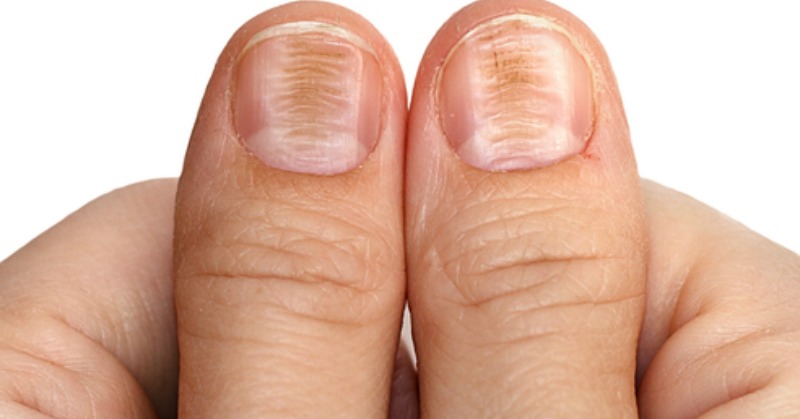by Ben Fuchs
We humans love our nails. We spend nearly 8 billion dollars a year on those hard dead shell like materials on the tips of our fingers and toes. While adorning them with polish, varnish and even art may imply “cosmetic” and “superficial”, as it turns out, their condition, for better or worse, is a function of the entire body, and if you’re observant you can tell a lot about overall physical health by looking at the nails.
Technically speaking, nails are an extension of the skin. They’re a modified version of the epidermis, the top layer that composes about 10 percent of the body’s largest organ. Although it may look like one uniform structure, in reality, the nail (like the skin) is composed of numerous layers lying atop of each other. In fact, the average fingernail is composed of 25 of these ultra-thin slices that fuse into a firm, slightly elastic form by the action of microscopic threads called keratin. This is what gives them remarkable resilience and horse-hoof like strength. Keratin is a hard, flexible protein substance that is a common feature of hooves, horns, antlers, as well as the outer sheath that coats human hair. In addition to keratin, nails contain lots of minerals too, including: Iron, Carbon, Magnesium, Selenium, Silica, Calcium, Potassium, Phosphorus, Sulfur and Oxygen, all of which contribute to their characteristic qualities. Interestingly the nail appendage (technically called the “nail organ”) also contains small amounts of the well-known cosmetic ingredient called glycolic acid, which acts to trap water and assure hydration.
Because of their rapid growth (healthy fingernails grow up to 4mm a month) the nails are an accurate portal into the inside of the body. While the eyes may be the window to the soul, the nails can be thought of as windows to your biochemistry. There’s a lot of information a good health care professional can glean from their appearance.
As they are part of the skin, most nail conditions are assessed by dermatologists. Nail disorders account for 10 percent of all dermatological conditions.
Patients with soft, flaky nails that are prone to splitting may be missing minerals, particularly selenium and magnesium. “Terry Nails”, which are white nails with an opaque, “ground glass” look that occasionally have brown to pink bands, are associated with chronic liver disease. And spoon shaped nails, the mark of a condition called Koilonychia (pronounced: “coyl-oni-kia”), are classically a sign of iron deficiency.
While normal nails exhibit a pink color, which indicates healthy blood flow underneath, nails that are pale or white may indicate circulatory problems such as a low red blood cell count, anemia, and perhaps kidney disease. On the other hand, nails that have a beet red hue may point towards heart disease. Nails that are white and grainy with a rosy red strip can be indicative of liver cirrhosis, hyperthyroidism, diabetes, or HIV. Sometimes, abnormal circulation in the nail bed creates the appearance of horizontal white lines, most often in the middle three fingers. Because this problem occurs in the nail bed, it will not progress up as the nail grows.
This condition which dermatologists call “Muehrcke’s Nails”, can be caused by liver disease and chemotherapy. Other causes of horizontal white lines include Hodgkin disease, kidney failure, system-wide infection, or poisoning by arsenic, thallium, or other heavy metals.
Nutritional status also plays an important role in nail health. Because of their rapid growth, shortages in key nutrients will show up in the nails before any other part of the body. As mentioned above a lack of magnesium can lead to nail softening and shortages of iron can cause them to spoon becoming concave, rather than convex.
Other minerals like calcium, sulfur, zinc and silica are critical for nail strength and resilience. Vitamin D is essential for calcium absorption and a dearth can also have an impact. A lack of the B-vitamins (especially B-12) and Vitamins A and C can affect nail shape and create both horizontal and vertical ridges, and because the nail is mostly made up of protein both lack of intake as well as digestive impairment can lead to nail thinness and fragility. Essential Fatty Acids are important and nail cracking and splitting can result under conditions of Omega-6 deficiency. Low levels of digestive juice (i.e. enzymes and stomach acid) can compromise the absorption of minerals even when they’re present in the diet. Likewise, in the case of gall bladder disease or its removal, mineral absorption can be compromised resulting in unhealthy nails.
Did you know…
Nail biting which affects one out of three children between the ages of 7 and 10 and nearly half of all teenagers is considered to be a mental health issue and is classified as a type of Obsessive Compulsive Disorder.
Nails grow faster in the summer than the winter, grow faster after illnesses and grow faster on the fingers of your dominant hand. The nails of the middle finger exhibit the most rapid growth and the thumbnail grows the slowest.
According to the Guinness Book of World Records, the longest fingernails ever recorded on a woman measured over 28 feet. The nails were on the hand of a California woman named Lee Redmond who started manicuring them in 1979 until she lost them in an automobile accident in 2009.



